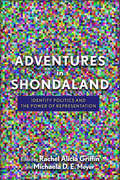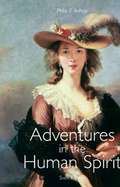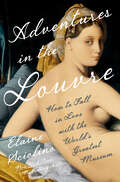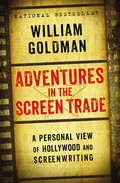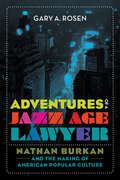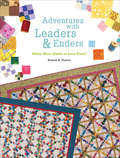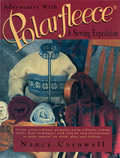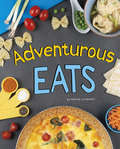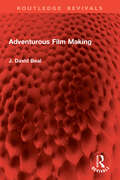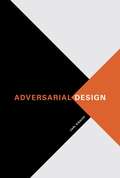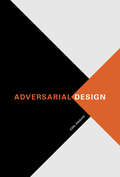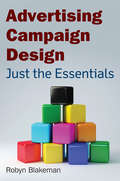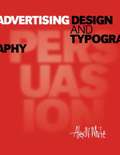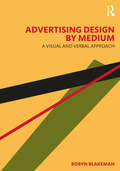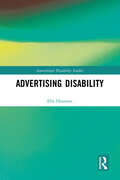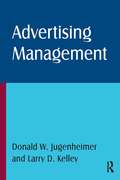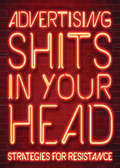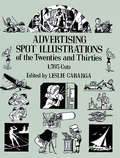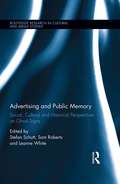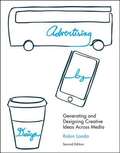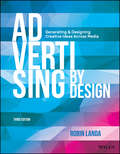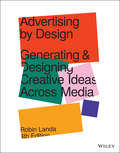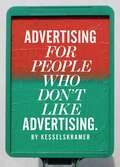- Table View
- List View
Adventures in Shondaland: Identity Politics and the Power of Representation
by Stephanie Young Vincent Pham Tina Harris Melissa Ames Mark P Orbe Michaela D.E. Meyer Rachel Alicia Griffin Richard G Jones Emily Vajjala Joan Faber McAlister Jessica L Furgerson Jennifer Billinson Jade Petermon Shadee Abdi Bernadette Calafell Myra Washington Mary Ingram-Waters Leslie Balderas Sean SwensonShonda Rhimes is one of the most powerful players in contemporary American network television. Beginning with her break-out hit series Grey’s Anatomy, she has successfully debuted Private Practice, Scandal, How to Get Away with Murder, The Catch, For The People, and Station 19. Rhimes’s work is attentive to identity politics, “post-” identity politics, power, and representation, addressing innumerable societal issues. Rhimes intentionally addresses these issues with diverse characters and story lines that center, for example, on interracial friendships and relationships, LGBTIQ relationships and parenting, the impact of disability on familial and work dynamics, and complex representations of womanhood. This volume serves as a means to theorize Rhimes’s contributions and influence by inspiring provocative conversations about television as a deeply politicized institution and exploring how Rhimes fits into the implications of twenty-first century television.
Adventures in the Human Spirit
by Philip E. BishopFor a one semester survey course in Introduction to Humanities. This single-volume text is a historical survey of the western humanities. Written to be accessible to students with little background in the arts and humanities, Adventure in the Human Spirit provides a balanced introduction to the major arts, philosophy, and religion. This text approaches the humanities by focusing on principal events, styles, movements, and figures, bringing the past to life.
Adventures in the Louvre: How to Fall in Love with the World's Greatest Museum
by Elaine SciolinoA former New York Times Paris bureau chief explores the Louvre, offering an intimate journey of discovery and revelation. The Louvre is the most famous museum in the world, attracting millions of visitors every year with its masterpieces. In Adventures in the Louvre, Elaine Sciolino immerses herself in this magical space and helps us fall in love with what was once a forbidding fortress. Exploring galleries, basements, rooftops, and gardens, Sciolino demystifies the Louvre, introducing us to her favorite artworks, both legendary and overlooked, and to the people who are the museum’s lifeblood: the curators, the artisans producing frames and engravings, the builders overseeing restorations, the firefighters protecting the aging structure. Blending investigative journalism, travelogue, history, and memoir, Sciolino walks her readers through the museum’s front gates and immerses them in its irresistible, engrossing world of beauty and culture. Adventures in the Louvre reveals the secrets of this grand monument of Paris and basks in its timeless, seductive power.
Adventures in the Screen Trade
by William GoldmanNow available as an ebook for the first time!No one knows the writer's Hollywood more intimately than William Goldman. Two-time Academy Award-winning screenwriter and the bestselling author of Marathon Man, Tinsel, Boys and Girls Together, and other novels, Goldman now takes you into Hollywood's inner sanctums...on and behind the scenes for Butch Cassidy and the Sundance Kid, All the President's Men, and other films...into the plush offices of Hollywood producers...into the working lives of acting greats such as Redford, Olivier, Newman, and Hoffman...and into his own professional experiences and creative thought processes in the crafting of screenplays. You get a firsthand look at why and how films get made and what elements make a good screenplay. Says columnist Liz Smith, "You'll be fascinated.
Adventures of Perception: Essays / Interviews
by Scott MacdonaldIn this collection of thematically related personal essays and conversations with filmmakers, the author takes us on a fascinating journey into many under-explored territories of cinema.
Adventures of a Jazz Age Lawyer: Nathan Burkan and the Making of American Popular Culture
by Gary A. RosenAdventures of a Jazz Age Lawyer is the lively story of legal giant Nathan Burkan, whose career encapsulated the coming of age of the institutions, archetypes, and attitudes that define American popular culture. With a client list that included Charlie Chaplin, Al Jolson, Frank Costello, Victor Herbert, Mae West, Gloria Morgan Vanderbilt, Arnold Rothstein, and Samuel Goldwyn, Burkan was “New York’s Spotlight Lawyer” for more than three decades. He was one of the principal authors of the epochal Copyright Act of 1909 and the guiding spirit behind the American Society of Composers, Authors, and Publishers (Ascap), which provided the first practical means for songwriters to collect royalties for public performances of their works, revolutionizing the music business and the sound of popular music. While the entertainment world adapted to the disruptive technologies of recorded sound, motion pictures, and broadcasting, Burkan’s groundbreaking work laid the legal foundation for the Great American Songbook and the Golden Age of Hollywood, and it continues to influence popular culture today.Gary A. Rosen tells stories of dramatic and uproarious courtroom confrontations, scandalous escapades of the rich and famous, and momentous clashes of powerful political, economic, and cultural forces. Out of these conflicts, the United States emerged as the world’s leading exporter of creative energy. Adventures of a Jazz Age Lawyer is an engaging look at the life of Nathan Burkan, a captivating history of entertainment and intellectual property law in the early twentieth century, and a rich source of new discoveries for anyone interested in the spirit of the Jazz Age.
Adventures with Leaders & Enders: Make More Quilts in Less Time!
by Bonnie K. HunterAn easy method to faster quilt-making, and incredible patterns to make use of your scrap stash. What if you could piece quilts even faster, work on more than one quilt simultaneously and save money, fabric and thread all at the same time? Bonnie K. Hunter will show you how to put the concept of Leaders & Enders to work quickly and easily, expanding your creativity, and upping your productivity all at the same time. If you have ever found yourself paralyzed by your stash, overwhelmed by scraps you just can't bear to toss out, arm yourself with a new rotary blade for your cutter, make yourself a cup of tea and start reading. This book is not only full of beautiful scrap quilts that can be made in between the lines of other sewing, but also contains many ideas for getting your ever burgeoning scrap stash under control, into useable sized pieces that work well with one another, and ready to be sewn into quilts you've always wanted to make. Bonnie K. Hunter has done it again!
Adventures with Polarfleece: A Sewing Expedition
by Nancy CornwellJourney into virtually uncharted territory and discover the wonderful uses of fleece! Allow author Nancy Cornweel to lead you on a sewing expedition. Adventures with Polarfleece covers territories as fabric and garment care, sewing machine and serger basics, pattern choices and simple design changes. Included are 200 photographs and 150 color illustrations to guide you on a tour of quick and easy techniques for seams, ready-to-wear edge finishing and no-hassle zippers. Nancy also shows a safety technique on how to avoid the dreaded "frog mouth" buttonhole! Adventures with Polarfleece also includes a special excursion in ultrasuede - drawcords, patches, button loops, piping and pockets; sculpturing, polar pintucks and embroidery. A collection of fifteen projects are included. This sewing expedition has been photographed every step of the way and is clearly mapped and illustrated. Included are instructions for jackets, pull-overs, a cape, a five-minuet hat, blankets, pillows, exceptional accessories and more! Explore and discover the endless project possibilities for the entire family. Fleece is one of the sewing world's premier fabrics for comfort and warmth. It is easy to sew with beautiful results. Nancy Cornwell will lead you down a path of discovery filled with excitement, intrigue and inspiration. If the urge to explore is part of your nature, Adventures with Polarfleece is sure to generate great excitement. The heart of a fallen-away sewer will soon be recaptured and new sewers will be intrigued and inspired.
Adventurous Eats (Easy Eats)
by Katrina JorgensenLooking for new recipes that will challenge those blossoming cooks? Adventurous Eats will push developing cooks to the next level of kitchen creativity. Try a new flavor combination or a cuisine from across the globe. These recipes are both tasty and tempting!
Adventurous Film Making (Routledge Revivals)
by J. David BealAdventurous Film Making (1980) looks at some more ambitious and interesting techniques and shows how these serve film makers in expressing their ideas. This volume spans every kind of film: travel, action, recreations of the past, visual and verbal comedy, the natural world, cartoon and puppet animation, true-life adventures, sporting events, fantasy and science fiction. It focuses on the more advanced use of equipment, and discusses all aspects of shooting and editing, and also reveals for the first time the particular methods chosen by some of the most talented and successful amateur film makers, each an acknowledge specialist in their chosen field.
Adversarial Design
by Carl DisalvoIn Adversarial Design, Carl DiSalvo examines the ways that technology design can provoke and engage the political. He describes a practice, which he terms "adversarial design," that uses the means and forms of design to challenge beliefs, values, and what is taken to be fact. It is not simply applying design to politics--attempting to improve governance for example, by redesigning ballots and polling places; it is implicitly contestational and strives to question conventional approaches to political issues. DiSalvo explores the political qualities and potentials of design by examining a series of projects that span design and art, engineering and computer science, agitprop and consumer products. He views these projects-- which include computational visualizations of networks of power and influence, therapy robots that shape sociability, and everyday objects embedded with microchips that enable users to circumvent surveillance--through the lens of agonism, a political theory that emphasizes contention as foundational to democracy. Each of these projects engages one of three categories as a medium--information, robots, and ubiquitous computing--and in each of them certain distinctive qualities of computation are used for political ends or to bring forth political issues. DiSalvo's illuminating analysis aims to provide design criticism with a new approach for thinking about the relationship between forms of political expression, computation as a medium, and the processes and products of design.
Adversarial Design (Design Thinking, Design Theory)
by Carl DisalvoAn exploration of the political qualities of technology design, as seen in projects that span art, computer science, and consumer products.In Adversarial Design, Carl DiSalvo examines the ways that technology design can provoke and engage the political. He describes a practice, which he terms “adversarial design,” that uses the means and forms of design to challenge beliefs, values, and what is taken to be fact. It is not simply applying design to politics—attempting to improve governance for example, by redesigning ballots and polling places; it is implicitly contestational and strives to question conventional approaches to political issues. DiSalvo explores the political qualities and potentials of design by examining a series of projects that span design and art, engineering and computer science, agitprop and consumer products. He views these projects—which include computational visualizations of networks of power and influence, therapy robots that shape sociability, and everyday objects embedded with microchips that enable users to circumvent surveillance—through the lens of agonism, a political theory that emphasizes contention as foundational to democracy. DiSalvo's illuminating analysis aims to provide design criticism with a new approach for thinking about the relationship between forms of political expression, computation as a medium, and the processes and products of design.
Advertising Campaign Design: Just the Essentials
by Robyn BlakemanThe author's step-by-step approach to campaign design dissects the creative process necessary to design a successful integrated marketing communications campaign one topic at a time, creating an invaluable research tool that students and professors alike will refer to time and time again.
Advertising Design and Typography
by Alex W. WhiteThe most comprehensive overview of advertising design strategies on the market today! This unique, comprehensive overview of advertising design strategies, written by a best-selling, award-winning designer, will help students and professionals in advertising, design, and typography understand and use persuasive visual messaging. Design principles such as unity, contrast, hierarchy, dominance, scale, abstraction, and type and image relationships are covered in depth. Readers will also learn how print design compares to television, web, and interactive design, and how to apply each style to create persuasive designs. The extensive section on typography offers essential information on how readers perceive type, typographic history, principles, and practice. Helpful appendices include an extensive glossary, bibliography, and art director's checklist. Complete with more than 1,500 examples and illustrations of outstanding advertising design from around the world, Advertising Design and Typography is a groundbreaking book that will train the reader's mind to see more accurately and more critically-ultimately changing the way designers think and develop visual ideas. Best-selling design author has unique philosophy and expertise 1,500 full-color illustrations showcase outstanding advertising design from around the world Unique comparisons of print, web, TV and other campaigns-which techniques work best? Ideas for forging corporate identity through advertising
Advertising Design by Medium: A Visual and Verbal Approach
by Robyn BlakemanConceived to give readers the principles and the tools to create successful advertisements in a variety of mediums, this book is a detailed exploration of how visual and verbal elements of design work together to solve a business goal. Effective visual and verbal design solutions are more than just a good idea; they are purposeful, on-target, on-strategy, and recognizable no matter where, or in what form, they appear. Success depends on creative teams’ understanding of ideation, layout, type, color, varied image formats, copywriting, media advantages and limitations, and production procedures for varied media formats. The step-by-step approach of this book goes beyond broad theoretical discussions on copy and design. Instead, the book dissects the creative process into individualized and detailed discussions both creative and non-creative students alike can understand and employ. This book is ideal as a textbook for design courses within programs in advertising, graphic design, integrated marketing communication, strategic marketing, entrepreneurship, business, and mass communication. Accompanying the text are online materials for instructors: lecture slides, a testbank, and an instructor manual. www.routledge.com/9781032183596
Advertising Disability (Autocritical Disability Studies)
by Ella HoustonAdvertising Disability invites Cultural Disability Studies to consider how advertising, as one of the most ubiquitous forms of popular culture, shapes attitudes towards disability. The research presented in the book provides a much-needed examination of the ways in which disability and mental health issues are depicted in different types of advertising, including charity 'sadvertisements', direct-to-consumer pharmaceutical advertisements and 'pro-diversity' brand campaigns. Textual analyses of advertisements from the eighteenth century onwards reveal how advertising reinforces barriers facing disabled people, such as stigmatising attitudes, ableist beauty 'ideals', inclusionism and the unstable crutch of charity. As well as investigating how socio-cultural meanings associated with disability are influenced by multimodal forms of communication in advertising, insights from empirical research conducted with disabled women in the United Kingdom and the United States are provided. Moving beyond traditional textual approaches to analysing cultural representations, the book emphasises how disabled people and activists develop counternarratives informed by their personal experiences of disability, challenging ableist messages promoted by advertisements. From start to finish, activist concepts developed by the Disabled People's Movement and individuals' embodied knowledge surrounding disability, impairments and mental health issues inform critiques of advertisements.Its critically informed approach to analysing portrayals of disability is relevant to advertisers, scholars and students in advertising studies and media studies who are interested in portraying diversity in marketing and promotional materials as well as scholars and students of disability studies and sociology more broadly.
Advertising Management
by Larry D Kelley Donald W Jugenheimer Fogarty Klein MonroeThis comprehensive book is designed to serve as a primary text for the Advertising Management course that follows the more general Principles of Advertising course. It can stand alone, or, for instructors who prefer a case-based approach, it can be adopted together with "Cases in Advertising Management" (978-0-7656-2261-7) by the same authors. "Advertising Management" covers a full range of topics for a semester-long course, including financial management, business planning, strategic planning, budgeting, human resource management, ethics, and managing change. There is even a unique section on 'managing yourself' and your own career in advertising. The text includes plentiful figures, tables, and sidebars, and each chapter concludes with useful learning objectives, summaries, discussion questions, and additional resources.
Advertising Shits in Your Head: Strategies for Resistance
by Vyvian RaoulAdvertising Shits in Your Head calls ads what they are—a powerful means of control through manipulation—and highlights how people across the world are fighting back. It diagnoses the problem and offers practical tips for a DIY remedy. Faced with an ad-saturated world, activists are fighting back, equipped with stencils, printers, high-visibility vests, and utility tools. Their aim is to subvert the advertisements that control us. With case studies from both sides of the Atlantic, this book showcases the ways in which small groups of activists are taking on corporations and states at their own game: propaganda. This is a call-to-arts for a generation raised on ads. Beginning with a rich and detailed analysis of the pernicious hold advertising has on our lives, the book then moves on to offer practical solutions and guidance on how to subvert the ads. Using a combination of ethnographic research and theoretical analysis, Advertising Shits in Your Head investigates the claims made by subvertising practitioners and shows how they affect their practice.
Advertising Spot Illustrations of the Twenties and Thirties: 1,593 Cuts (Dover Pictorial Archive)
by Leslie CabargaLively collection of royalty-free spots for commercial artists dramatizes a host of enterprises: business, communications, education, industry, construction, transportation, legal and healthcare services, sports, travel, entertainment, and much more -- all conveniently arranged by category for ease of use.
Advertising and Public Memory: Social, Cultural and Historical Perspectives on Ghost Signs (Routledge Research in Cultural and Media Studies)
by Sam Roberts Leanne White Stefan SchuttThis is the first scholarly collection to examine the social and cultural aspects on the worldwide interest in the faded remains of advertising signage (popularly known as ‘ghost signs’). Contributors to this volume examine the complex relationships between the signs and those who commissioned them, painted them, viewed them and view them today. Topics covered include cultural memory, urban change, modernity and belonging, local history and place-making, the crowd-sourced use of online mobile and social media to document and share digital artefacts, ‘retro’ design and the resurgence in interest in the handmade. The book is international and interdisciplinary, combining academic analysis and critical input from practitioners and researchers in areas such as cultural studies, destination marketing, heritage advertising, design, social history and commercial archaeology.
Advertising by Design
by Robin LandaDon't miss the new updated edition of the complete guide to the creative processes behind successful advertising design.The second edition of Advertising by Design has been developed and greatly expanded. Sill the most comprehensive text on creative concept generation and designing for advertising, the book includes a number of features that make it an effective tool for instructors, students, or anyone interested in this field. This includes a practical approach to generating and designing creative integrated-media advertising for brands, organizations, and causes that encompasses brand-building through engagement, community building, added value, and entertainment.Fully supplemented with interviews from esteemed creative directors, along with real-world examples, Advertising by Design is both a perfect text for courses that incorporate advertising concepts and design, and a valuable reference for anyone interested in the creative side of advertising."While the blank piece of paper is exciting, it can also be a very scary place. Robin Landa has created a valuable tool for jump-starting the creative process across all platforms. This book is a must-read for beginners and seasoned veterans."-- Paul Renner, EVP Group Creative Director, Arnold Worldwide, Boston"This is still the quintessential, step-by-step textbook for anyone interested in learning or teaching the fundamentals of advertising."-- Alan Rado, IADT/Harrington College of Design"The most enlightening textbook on advertising I've ever seen. A must-read for any student of the ad biz." -- Drew Neisser, CEO, Renegade"So perfect for a creative strategist, transformational world. Very few books get it right about the evolution of creative. This one does, from strategy to storytelling to multiple media solutions. And it's still all about doing beautiful work."-- Deborah Morrison, Chambers Distinguished Professor of Advertising, University of Oregon
Advertising by Design: Generating and Designing Creative Ideas Across Media
by Robin LandaRecognizing that good advertising is about creating an engaging story, the Third Edition of Advertising by Design looks at advertising design as a form of content creation that blends ideas, information, and entertainment in a way that can work for a ranged of media or audience types. Fully updated to align with the latest trends in the advertising industry, the book includes new information on transmedia campaigns, social media, digital media, pull marketing, creative content, and branded entertainment. It continues to offer a step-by-step introduction to the fundamentals of advertising design, giving students the guidance they need to jump-start their creative process no matter what media channel they're working in.
Advertising by Design: Generating and Designing Creative Ideas Across Media
by Robin LandaA real-world introduction to advertising design and art direction, updated and revised for today's industry The newly revised Fourth Edition of Advertising by Design: Generating and Designing Creative Ideas Across Media delivers an invigorating and cutting-edge take on concept generation, art direction, design, and media channels for advertising. The book offers principles, theories, step-by-step instructions, and advice from esteemed experts to guide you through the fundamentals of advertising design and the creative process. With a fresh focus on building a coherent brand campaign through storytelling across all media channels, Advertising by Design shows you how to conceive ideas based on strategy, build brands with compelling advertising, and encourage social media participation. You’ll also get insights from guest essays and interviews with world-leading creatives in the advertising industry. The book is filled with practical case studies that show real-world applications. You’ll also benefit from coverage of A quick start guide to advertising A thorough introduction to what advertising is, including its purpose, categories, forms, media channels, social media listening, and its creators Creative thinking strategies and how to generate ideas based on creative briefs Utilizing brand archetypes and creating unique branded content Composition by design, including the parts of an ad, the relationship between images and copy, basic design principles, and points of view How to build a brand narrative in the digital age Copywriting how-to’s for art directors and designers Experiential advertising An examination of digital design, including subsections on the basics of mobile and desktop website design, motion, digital branding, and social media design Perfect for students and instructors of advertising design, art direction, graphic design, communication design, and copywriting, Advertising by Design also will earn a place in the libraries of business owners, executives, managers, and employees whose work requires them to understand and execute on branding initiatives, advertising campaigns, and other customer-facing content.
Advertising for People Who Don't Like Advertising
by KesselsKramerThis is a book by a company that dislikes advertising as much as anyone. Nevertheless, it makes adverts. It has worked with global brands to produce fashion collections and promoted a town with a mass wedding. It creates advertising with more human, truthful communications. The company's name is KesselsKramer.This book describes how to make something you like out of something you don't. As well as drawing on its own experiences, KesselsKramer listens and learns from those who doubt the advertising industry. Stefan Sagmeister explains how quitting work makes you better at working; Hans Aarsman discusses authenticity in image-making; and Alex Bogusky looks at ways to help capitalism grow up.Advertising for People Who Don't Like Advertising is partly a creative handbook and partly an attempt to make the world a very slightly better place. It's intended for anyone who has ever hated a web banner or zapped an ad break.
Advertising for People Who Don't Like Advertising
by KesselsKramer KesselsKramerThis is a book by a company that dislikes advertising as much as anyone. Nevertheless, it makes adverts. It has worked with global brands to produce fashion collections and promoted a town with a mass wedding. It creates advertising with more human, truthful communications. The company's name is KesselsKramer.This book describes how to make something you like out of something you don't. As well as drawing on its own experiences, KesselsKramer listens and learns from those who doubt the advertising industry. Stefan Sagmeister explains how quitting work makes you better at working; Hans Aarsman discusses authenticity in image-making; and Alex Bogusky looks at ways to help capitalism grow up.Advertising for People Who Don't Like Advertising is partly a creative handbook and partly an attempt to make the world a very slightly better place. It's intended for anyone who has ever hated a web banner or zapped an ad break.
